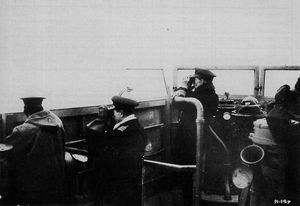Roger Roland Charles Backhouse: Difference between revisions
No edit summary |
(use {{DEFAULTSORT:}} for categories) |
||
| Line 62: | Line 62: | ||
{{TabEnd}} | {{TabEnd}} | ||
[[Category:1878 births | {{DEFAULTSORT:Backhouse, Roger}} | ||
[[Category:1939 deaths | |||
[[Category:Personalities | [[Category:1878 births]] | ||
[[Category:H.M.S. Britannia (Training Ship) Entrants of July, 1892 | [[Category:1939 deaths]] | ||
[[Category:Royal Navy Gunnery Officers | [[Category:Personalities]] | ||
[[Category:Captains of H.M.S. Conquest (1915) | [[Category:H.M.S. Britannia (Training Ship) Entrants of July, 1892]] | ||
[[Category:Captains of H.M.S. Lion (1910) | [[Category:Royal Navy Gunnery Officers]] | ||
[[Category:Captains of H.M.S. Malaya (1915) | [[Category:Captains of H.M.S. Conquest (1915)]] | ||
[[Category:First Sea Lords | [[Category:Captains of H.M.S. Lion (1910)]] | ||
[[Category:Royal Navy Admirals of the Fleet | [[Category:Captains of H.M.S. Malaya (1915)]] | ||
[[Category:Royal Navy Flag Officers | [[Category:First Sea Lords]] | ||
[[Category:Royal Navy Admirals of the Fleet]] | |||
[[Category:Royal Navy Flag Officers]] | |||
Revision as of 19:28, 31 July 2012

Photo: Library and Archives Canada PA-6543.
Admiral of the Fleet SIR Roger Roland Charles Backhouse, G.C.B., G.C.V.O., Royal Navy, Retired (24 November, 1878 – 15 July, 1939) was an officer of the Royal Navy.
Life & Career
Backhouse was confirmed in the rank of Sub-Lieutenant dated 15 march, 1898, and was promoted to the rank of Lieutenant dated 15 March, 1899.[1]
He was promoted to the rank of Commander on 31 December, 1909.[2]
Backhouse was appointed an Ordinary Member of the Third Class, or Companion, in the Civil Division of the Most Honourable Order of the Bath (C.B.) on 1 January, 1914.[3]
Great War
On 4 August, 1914, Admiral Sir John R. Jellicoe succeeded Sir George Callaghan in command of the First Fleet of the Home Fleets, or Grand Fleet. Backhouse was reappointed as Jellicoe's Flag Commander, and on 5 August Britain went to war with Germany. On 1 September he was promoted to the rank of Captain,[4] and reappointed to Jellicoe's staff for special service.
Backhouse was appointed to H.M.S. President on 9 October, 1915, for special service, and on 12 November was given command of the light cruiser Conquest in the Harwich force under Commodore (Sir) Reginald Yorke Tyrwhitt. He had an exciting year and incidents were numerous. When German battle cruisers bombarded Lowestoft on 25 April 1916 the commodore, flying his broad pennant in the Conquest, intervened with three light cruisers and sixteen destroyers and drew off the enemy's fire. In turning to retire the Conquest was hit by four or five 12-inch shells; twenty-three of her crew were killed and sixteen wounded, and a serious fire broke out. Backhouse's conduct in leaving the bridge directly the shellfire had ceased and taking personal charge of the operation was given official approbation by the Board of Admiralty; "By his personal efforts he saved his ship from destruction."[5]
When Jellicoe went to the Admiralty as First Sea Lord in November, 1916, Vice-Admiral Sir David Beatty left the Battle Cruiser Fleet to become Commander-in-Chief, Grand Fleet. When Rear-Admiral William C. Pakenham succeeded Beatty in command of the renamed Battle Cruiser Force, Backhouse went to Lion as his Flag Captain and for Gunnery Duties in the Battle Cruiser Force. On 20 June, 1917, he was invested with the insignia of the C.M.G. aboard Princess Royal. Beginning in May, 1918, he had to go into hospital a number of times which necessitated his giving up command of Lion in June. On 7 October he was appointed to President for special service. On 6 November he was appointed Chief Staff Officer for Anti-Submarine Defences.[6]
Post-War
On 25 November Backhouse was appointed to President as a member of the Reconstruction Committee and Rear-Admiral Richard F. Phillimore's Post War Problems Committee, which duty he ceased on 4 August, 1919. He was appointed to President for service in the Naval Ordnance Department on 20 August, 1920, and was appointed Director of Naval Ordnance on 20 September 1920. He was appointed to the battleship Malaya on 17 January, 1923, and then commanded her until 15 August, 1924.[7]
On 3 April, 1925, he was promoted to the rank of Rear-Admiral, vice Richmond.[8]
He was promoted to the rank of Vice-Admiral on 10 October, 1929, vice Oliver Backhouse, placed on the Retired List.[9]
Footnotes
- ↑ London Gazette: no. 27080. p. 3103. 16 May, 1899.
- ↑ London Gazette: no. 28325. p. 29. 4 January, 1910.
- ↑ Edinburgh Gazette: no. 12630. p. 7. 2 January, 1914.
- ↑ London Gazette: no. 28902. p. 7293. 15 September, 1914.
- ↑ ADM 196/44. f. 474.
- ↑ ADM 196/44. f. 474.
- ↑ ADM 196/44. f. 474.
- ↑ London Gazette: no. 33038. p. 2566. 14 April, 1925.
- ↑ London Gazette: no. 33542. p. 6476. 11 October, 1929.
Bibliography
- "Sir Roger Backhouse" (Obituaries). The Times. Monday, 17 July, 1939. Issue 48359, col A, pg. 14.
Service Records
- The National Archives. ADM 196/142.
- The National Archives. ADM 196/125.
- The National Archives. ADM 196/90.
- The National Archives. ADM 196/44.
See Also
Template:ApptCaptTemplate:ApptCapt| Naval Appointments | ||
| Preceded by A. Ernle M. Chatfield |
Captain of H.M.S. Lion 1916 – 1918 |
Succeeded by Arthur J. Davies |
| Preceded by The Lord Chatfield |
First Sea Lord and Chief of Naval Staff 1935 – 1939 |
Succeeded by Sir A. Dudley P. R. Pound |